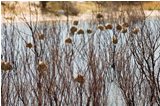Palm trees and weavers 2012-09-25 (270)
 In some areas weavers commonly use palm trees as nesting sites. In Cape Town, however, palm trees are rarely used. For instance, on Robben Island there are many palm trees but in surveys of all the Cape Weaver colonies not a single palm tree was used (see Robben survey). In Pinelands one colony is in a palm tree out of many colonies submitted to PHOWN (see here).
In some areas weavers commonly use palm trees as nesting sites. In Cape Town, however, palm trees are rarely used. For instance, on Robben Island there are many palm trees but in surveys of all the Cape Weaver colonies not a single palm tree was used (see Robben survey). In Pinelands one colony is in a palm tree out of many colonies submitted to PHOWN (see here).
Cornelis Reiman has been finding as many weaver colonies as possible in the southern parts of the Cape peninsula. He wrote the following about PHOWN record 2755:
"I had to go on to the residents property to take the photos and spoke to an elderly gentleman who was taking care of the house but is familiar with the owner.
He pointed out to me that the nests continuously fell from the palm tree as they did not anchor well. Numerous nests in good condition, could be seen on the ground. I thought about this and realise that the fronds are tapered downward and the birds clipped the branches of "leaves". Palms have no side branches, leaving no solid cross anchor points on the branches. Considering the wind pressure on the nests and flexible nature of the branches, the wind would place "downward" forces on the nest, as the branches are forced to bend down wind, causing nests to slip. It seemed to make a lot of sense that this this is not a suitable tree for them.
I then also noticed the very long woven attachments to the branches and will infer that the birds also realise the problem and try to compensate that way.
He then went on telling me that when the birds were in the previous tree which had to be removed not long ago, this did not happen. The birds had moved a short distance to the Palm tree after their original tree was cut down during building operations.
So here was a case of more forcible removals! "
So in very windy areas palm trees are not ideal as weaver nesting sites. If you have a weaver nest site that supports, or refutes, these ideas, submit your weaver nest records to PHOWN (PHOtos of Weaver Nests) via the Virtual Museum upload site.
| 










 In some areas weavers commonly use palm trees as nesting sites. In Cape Town, however, palm trees are rarely used. For instance, on Robben Island there are many palm trees but in surveys of all the Cape Weaver colonies not a single palm tree was used (see
In some areas weavers commonly use palm trees as nesting sites. In Cape Town, however, palm trees are rarely used. For instance, on Robben Island there are many palm trees but in surveys of all the Cape Weaver colonies not a single palm tree was used (see